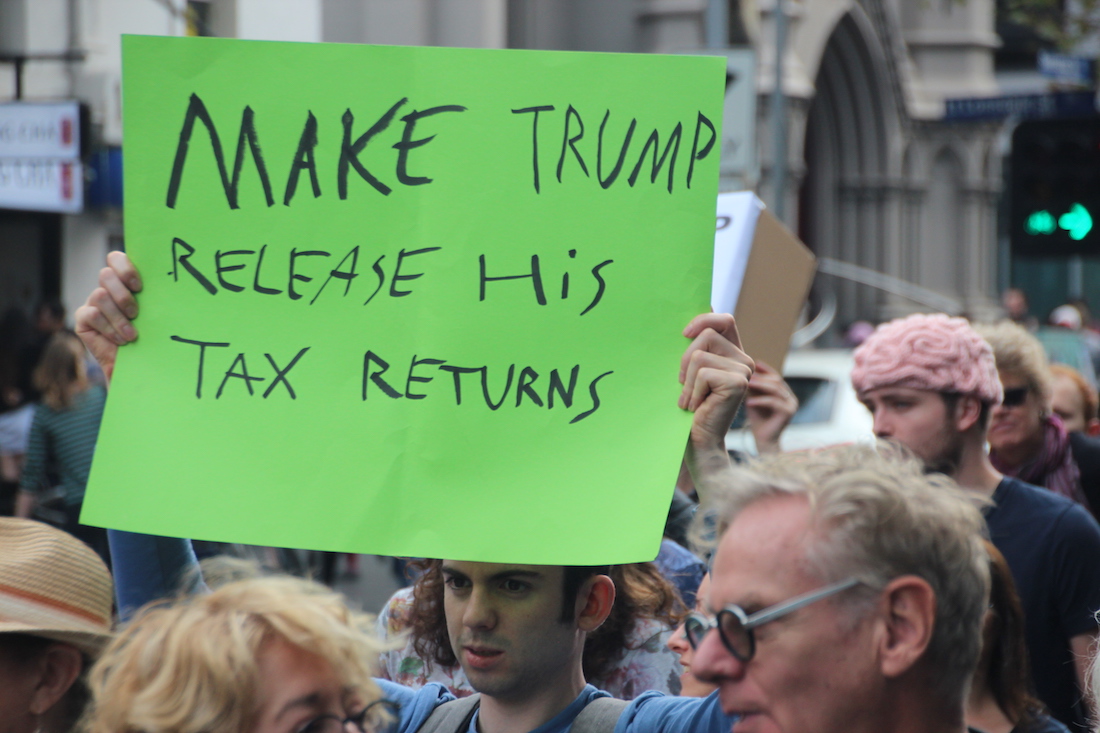A couple making $31,900 who file with the standard deduction would pay $750 in federal income tax. That amount – $750 – is also how much Donald Trump paid in federal taxes in 2016 and 2017. The New York Times released a summary of his tax returns that sheds light on the state of his finances. Most striking is the $750 tax bill, which many find ludicrous on its face.
The core of Trump’s strategy to achieve such low taxes was maximizing losses on paper and strategically spreading them over multiple years. The report also reveals that many of Trump’s tactics to avoid taxes are entirely legal. But focusing only on the legal nature of Trump’s actions would be a mistake; we must also examine the moral dimension of his actions. Trump’s tax returns are a story of how he stretched rules to their extreme. His actions reveal both his character and the brokenness of the rules themselves. Here are five lessons we can draw from his returns:
1. Trump’s disdain for the idea of taxes is reflected in his tax returns. He has said, “I try to pay as little tax as possible, because I hate what they do with my tax money.” At a minimum, his remarks imply that he does not see paying taxes as a necessary part of the social contract. His lawyers deftly negotiated tax law to move money around, create legal fictions, and use every trick in their power to lower his tax bill. More than 500 legal entities actually make up the Trump Organization, which enables him greater flexibility in how he files. In a smaller way, everyone uses the tax code to lower his or her bill. But Trump and other wealthy magnates have an army of accountants, lawyers, and consultants to discover and utilize every available legal loophole. Even when citizens do not agree with how their tax money is spent, the response should not be a disdain for paying taxes altogether but an attempt to make changes through the democratic system. Trump certainly does not understand taxes as a responsibility of a citizen.
2. Trump used business losses to lower his bill. Much of the debate centers around which of the losses are legitimate. Businesses are allowed to spread out large losses over multiple years in order to more accurately show profits in the years surrounding the loss. Furthermore, depreciation is a non-cash expense that is used to account for the reduction of value of an asset over the years. These processes are generally legitimate, as they allow businesses to better reflect their actual profits over a larger time period. But Trump used this concept year after year to lower his tax bill. His history of debt, bankruptcy, and rebound fueled this process. But changes to the law in 2009 allowed him to use this rule even beyond its usual scope.
3. Progressive policies helped Trump avoid taxes. President Obama instituted tax credits as a part of the 2009 bailout. Before the changes, losses could be used to regain taxes paid going back two years, but Obama’s provision doubled that allowance. Through the change, Trump secured a refund going back four years, which amounted to a whopping $70.1 million, plus interest. The status of this refund is currently held up in an audit, in which the IRS is attempting to claw back the refund; the case may eventually end up in federal court. The basis for the audit is once again how Trump accounted for his losses, with the IRS claiming that he claimed the losses wrongly. Additionally, Trump exploited a progressive environmental policy called a conservation easement, in which he promised not to develop land in return for a tax credit. This allowed him to erase even more of his tax bill.
4. Trump’s tax returns highlight the inequality in the tax code. The rich have resources to avoid taxes that are not available to the rest of society. For the majority of people, the complexity of tax code is a nightmare, costing countless hours and headaches. But for others, the complexity can be played to their advantage. For instance, Trump writes off many personal expenditures as business expenditures. The house which his children claim was the place of their childhood, is listed as a business investment and the depreciation claimed as a loss. He fully cashes in on carveouts to the law which give him credits for things such as restoring historic buildings. The buildings can then be used to make a profit and the credits used to avoid taxes. This creates a regressive tax code where the wealthy can elude taxes that the rest of society does not have the resources to avoid. The amount of taxes individuals pay or do not pay should not be determined by the resources they have to hire lawyers to fight IRS audits.
5. Donald Trump’s tax returns should be a motivation to pursue real tax reforms. Corruption in the tax code can be perfectly legal but still damaging to a fair system. A system of taxes provides for necessary functions of government and should be relatively straightforward in how it gathers those funds. Removing loopholes and substituting clear rules would rebuild trust in U.S. institutions.
It seems that Trump’s tax returns were not “big” and “beautiful,” as he has claimed, but instead reveal that he has avoided paying top tax rates for many years. The fact that Trump does not live at a level comparable to the couple making $31,900 is a core part of the feeling that this is illicit. Trump and his family lead a lavish lifestyle, but the taxes he pays are not proportionate to that lifestyle. The entire picture of his tactics to avoid taxes, which he has gone on record saying that he hates, reveals a portrait of a man and, much more, the tax system that enabled him.
(Photo credit: John Englart. CC BY-SA 2.0.)

